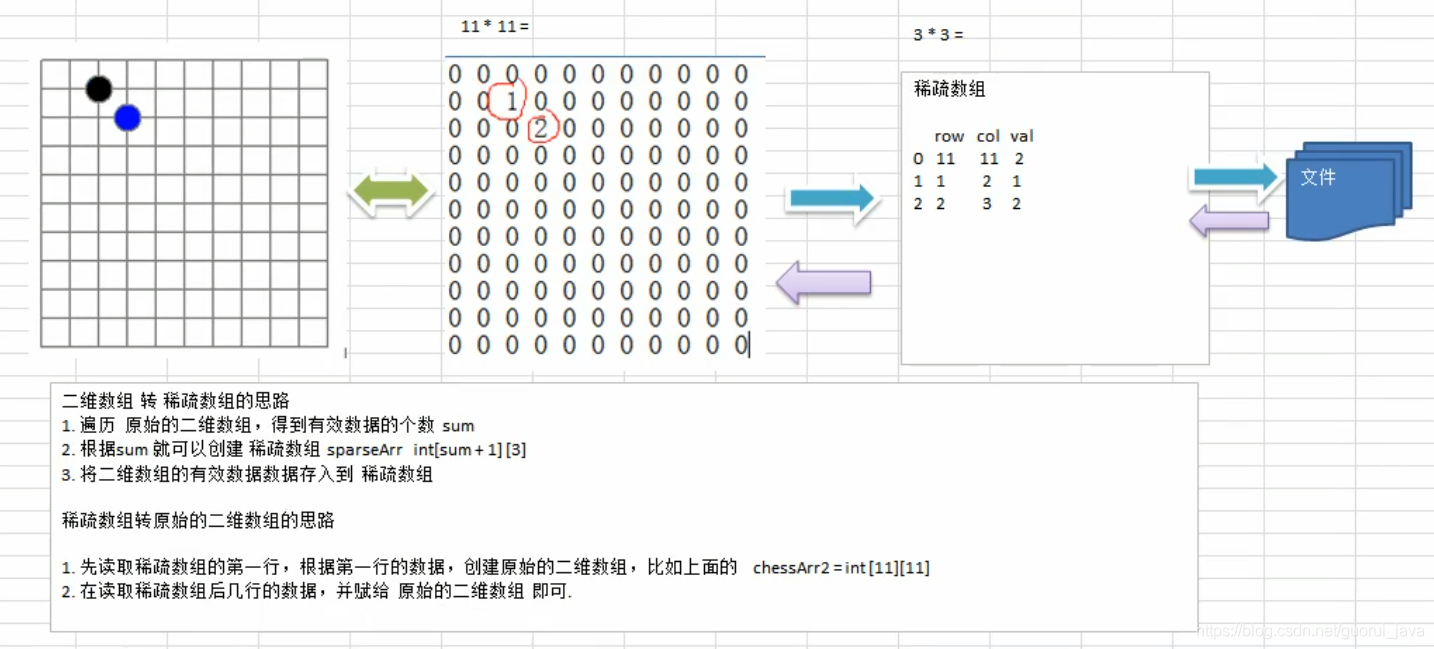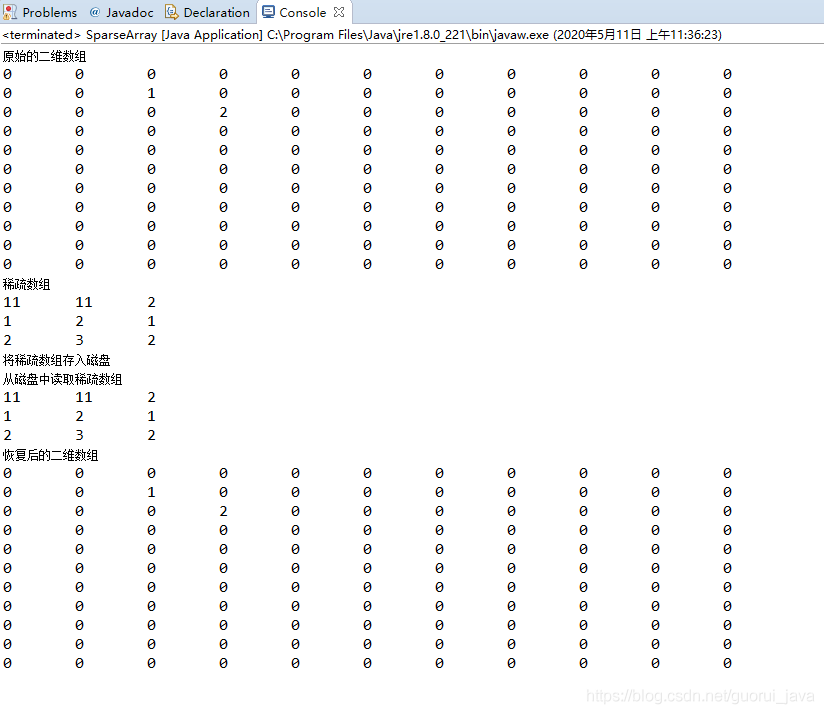原文地址:https://blog.csdn.net/guorui_java/article/details/106050189
一、稀疏数组
1.1 概念
当一个数组中部分元素是0,或者为同一个值的数组,可以使用稀疏数组来保存该数据。
稀疏数组的处理方法:
记录数组一共有几行几列,有多少个不同的值;
把具有不同值的元素的行列和值记录在一个小规模的数组中,从而缩小程序的规模。
1.2 存储
原数组中存在大量的无效数据,占据了大量的存储空间,真正有用的数据却少之又少;<br /> 压缩存储可以节省存储空间以避免资源的不必要的浪费,在数据序列化到磁盘时,压缩存储可以提高IO效率。<br />
二、代码实例
package com.atguigu.sparsearray;import java.io.File;import java.io.FileReader;import java.io.FileWriter;public class SparseArray {public static void sparseArrayToIO(int[][] sparseArr) throws Exception{System.out.println("将稀疏数组存入磁盘");File file = new File("D:/sparseArr.txt");if(!file.exists()){file.createNewFile();}FileWriter writer = new FileWriter(file);for(int i =0; i < sparseArr.length; i++) {for(int j = 0; j < 3; j++) {writer.write(sparseArr[i][j]);}}writer.flush();writer.close();}//从磁盘中读取稀疏数组public static int[][] sparseArrFromIO(int lines) throws Exception {System.out.println("从磁盘中读取稀疏数组");FileReader reader = new FileReader("D:/sparseArr.txt");int getNum = 0;int[][] sparseArray = new int[lines][3];for(int i = 0;i < lines;i++) {for (int j = 0; j < 3; j++) {getNum = reader.read();sparseArray[i][j] = getNum;}}return sparseArray;}public static void ArrSparseArrTransfer() {//先创建一个原始的二维数组//0表示没有棋子,1表示黑子,2表示蓝子int chessArr1[][] = new int[11][11];chessArr1[1][2] = 1;chessArr1[2][3] = 2;//输出原始的二维数组System.out.println("原始的二维数组");for(int[] row : chessArr1) {for(int data : row) {System.out.printf("%d\t",data);}System.out.println();}//将二维数组转稀疏数组的思路//1、先遍历二维数组,得到非0数据的个数int sum = 0;for(int i = 0;i<11;i++) {for(int j = 0;j<11;j++) {if(chessArr1[i][j]!=0) {sum++;}}}//2、创建稀疏数组int sparseArr[][] = new int[sum+1][3];//3、稀疏数组赋值sparseArr[0][0] = 11;sparseArr[0][1] = 11;sparseArr[0][2] = sum;//遍历二维数组,将非0的值存放到稀疏数组中int count = 0;//count 用来记录第几个非0数据for(int i = 0;i<11;i++) {for(int j = 0;j<11;j++) {if(chessArr1[i][j]!=0) {count++;sparseArr[count][0] = i;sparseArr[count][1] = j;sparseArr[count][2] = chessArr1[i][j];}}}//输出稀疏数组的形式System.out.println("稀疏数组");for(int[] row : sparseArr) {for(int data : row) {System.out.printf("%d\t",data);}System.out.println();}int sparseArr2[][] = new int[sum+1][3];try {sparseArrayToIO(sparseArr);sparseArr2 = sparseArrFromIO(3);for(int[] row : sparseArr2) {for(int data : row) {System.out.printf("%d\t",data);}System.out.println();}} catch (Exception e) {e.printStackTrace();}//稀疏数组恢复成原始的二维数组//1、先读取稀疏数组的第一行,根据第一行的数据,创建原始的二维数组int chessArr2[][] = new int[sparseArr2[0][0]][sparseArr2[0][1]];//2、再读取稀疏数组后几行的数据(从第二行开始),并赋给原始的二维数组即可for(int i = 1;i<sparseArr2.length;i++) {chessArr2[sparseArr2[i][0]][sparseArr2[i][1]] = sparseArr2[i][2];}//恢复后的二维数组System.out.println("恢复后的二维数组");for(int[] row : chessArr2) {for(int data : row) {System.out.printf("%d\t",data);}System.out.println();}}public static void main(String[] args) {ArrSparseArrTransfer();}}
三、控制台输出


